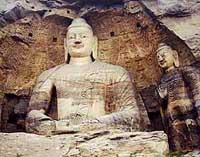
North China's Shanxi Province is investing 100 million yuan (US$12.09 million) to improve infrastructure and environment around the Yungang Grottoes, built more than 1,500 years ago.
The Yungang Grottoes were included in the World Heritage list in 2001.
The improvement project consists of three phases: construction and improvement of infrastructure; demolition and removal of unsightly buildings from scenic areas; and tree planting at the scenic site.
The Yungang Grottoes, 16 kilometers west of the city of Datong, were hewn from the cliffs in a honeycomb pattern and stretch for a kilometer from east to west.
Building of the grottoes began around 460 AD in the Northern Wei Dynasty. Within four decades, 1,000 grottoes and 100,000 Buddhist statues were completed together with large numbers of niches and colorful decorations.
The infrastructure construction and improvement project will cover the building of a water purification plant with a capacity of 300 tons of drinking water daily, a sewage treatment plant with a daily capacity of 1,400 tons and power, water and heating supply facilities.
The project is expected to be completed at the end of July next year, a source with the grottoes administration said.
The Yungang Grottoes have been extensively damaged over the centuries. At least 1,400 Buddhist statues were stolen and shipped out of the country.
Thanks to the government's persistent efforts to preserve the grottoes, cracked caves and statues have been reinforced and modern technologies have been used to prevent weathering.
About 51,000 statues remain, the largest at 17 meters high and the smallest two centimeters.
(eastday.com December 23, 2003)
|

